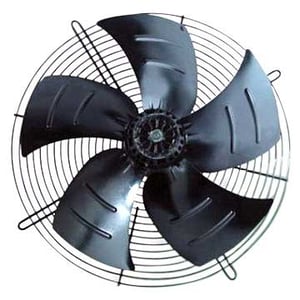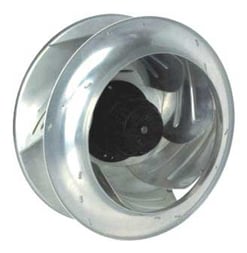A fan is a key component of any HVAC system. The most common HVAC fans are axial, forward-curved centrifugal, and backward-inclined, and each is uniquely suited to certain purposes. It’s important to understand each fan’s differences in energy efficiency, cost-effectiveness, and noise considerations. The wrong fan for the job could lead to reduced functionality and higher costs. Here’s what you need to know about the various fans for HVAC systems.
Axial Fans

Axial Fans, which include propeller, tube axial, and vane axial styles, move an air stream along the axis of the fan. These fans work like an airplane propeller—blades generate an aerodynamic lift that then pressurizes the air. Propeller fans embody only a motor and a propeller used to drive the airflow. Similar to a propeller fan, a tube axial fan includes a venturi that surrounds the fan propeller and is designed to reduce the air leak
age or vortices created by the spinning prop. A vane axial fan features vanes trailing the rear of the propeller, which straighten out the swirling airflow that occurs when the air is accelerated by the motor. Axial fans are inexpensive, compact, and light, making them a favorite for industrial applications. They are, however, usually noisier than centrifugal fans. Noise can be abated by insulating the duct; mounting the fan on soft materials like rubber or using a spring isolator to reduce the amount of transmitted vibration; or installation of sound dampening material or baffles.
Centrifugal Fans
Centrifugal Fans, which are categorized by their radial, forward curved, or backward inclined blade shapes, increase the speed of an air stream with a rotating impeller. The speed increases as the air reaches the ends of the blades and is then converted to pressure. These fans are able to produce high pressures, which makes them suitable for harsh operating conditions, such as systems with high temperatures or moist or dirty air streams. Tip vortices or tip leakage flow produced by the pressure differential across the airfoil section can be problematic with these basic fans.
Forward-Curved Centrifugal Fans, look more like hamster wheels and can create more air pressure. Because of this, they tend to be noisier than axial fans and require more power to run. They are durable, easy to clean and maintain, and have less problems with resistance. Forward-curved centrifugal fans are also called blowers.
Backward-Curved Centrifugal Fans are uncommonly shaped blades, which can be curved or straight, make these fans excellent for high volumes of airflow and variable resistance. They are often used for industrial purposes.
Applications of Fan Types
Though axial fans are usually the least expensive, they’re not the right solution for every situation. Because of their features and capabilities, they are best for compact electronics, automotive products, medical devices, and appliances as well as large applications such as cooling towers, vending machines, outdoor air conditioner compressors, and combustion engine cooling. Axial fans are also ideal as general-purpose fans.
Centrifugal fans are better for larger systems: air-handling units, air pollution and filtration systems, and drying systems. With incredible energy efficiency and versatility, these fans come in a variety of models, so you can find one to fit into a small, hard-to-reach space. They are also great options for dust collection, glass tempering, and incineration systems.
Choosing the right fan for your HVAC system is essential for its efficiency and performance. An axial fan, for example, won’t do as good a job managing the resistance compared to centrifugal fans of the same size in an air filtration system. Using an axial fan for that purpose would make the system perform poorly and likely lead to extra maintenance and repairs. Even though it would be less expensive initially, it would cost you more in the long run and would not function the way you would expect from such a system. Likewise, using a centrifugal fan in a cooling tower where it’s not needed would lead to unnecessary noise and increased costs.
Find the Perfect Fan for Your HVAC System Needs
Even among HVAC fan types, there are a variety of shapes and sizes that will help you narrow down the best option for your project. Take a look at our selection of fans listed in Pelonis Technologies' catalogue and see which one is right for you. If you’re still unsure on which fan is right for you, make sure to download our eBook, How to Select a Cooling Fan. Additionally, we can customize your choice to meet even the most demanding restrictions. If you have any questions or wish to learn more about HVAC system fans, contact our team today.





